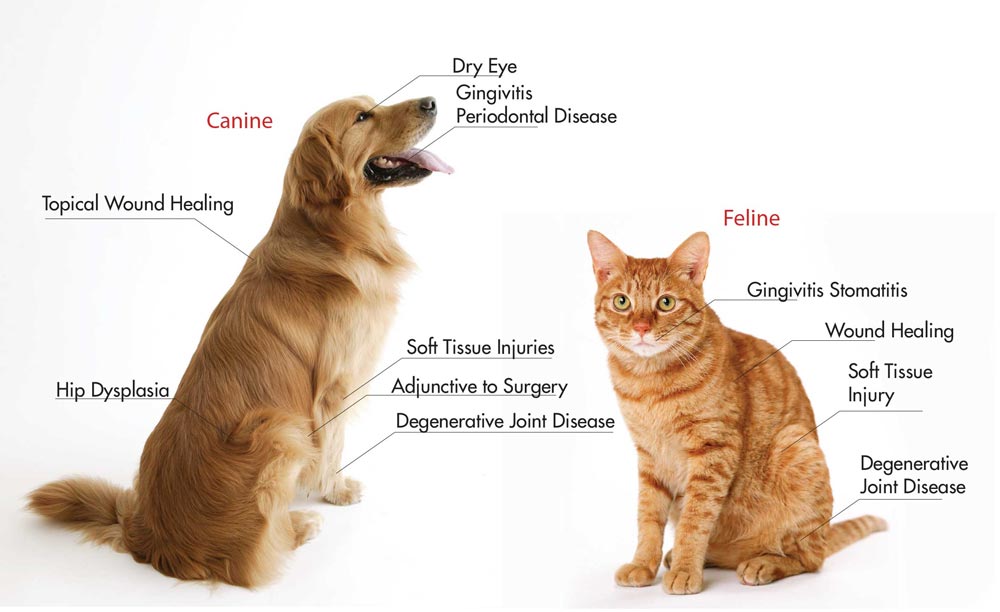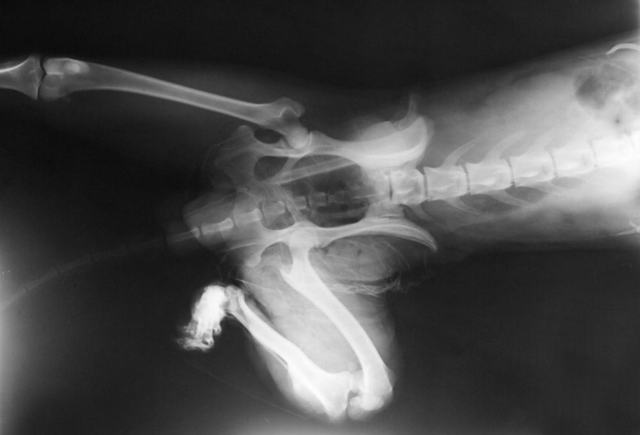Platelet Rich Plasma

Platelet-Rich Plasma, or PRP, is blood plasma that contains concentrated amounts of platelets and growth factors. PRP is a non-surgical and advanced means of providing high doses of the body’s own healing factors directly to the area where they are
needed.
How does it work?
Platelet Rich Plasma is a trending topic in human sports orthopedic medicine. Used for sports injuries as many wear and tear issues. MediVet’sPlatelet Rich Plasma Kit, or PRP, is a breakthrough product for pets utilizing blood plasma with concentrated platelets that once activated accelerate the healing properties of the isolated growth factors at a fraction of the cost of traditional human treatments.
Platelets that are found in whole blood contain many healing growth factors and bioactive proteins. These bioactive proteins can initiate tissue healing, and assist with inflammation. The treatment offers an affordable all natural alternative to drugs and steroids.

How does it benefit your pet?
Medivet’s PRP Kit can be introduced topically in or around an injured joint, tendon, or used in its gel form to treat large burns or wounds. MediVet’s PRP is not limited to acute injuries, it can also be used for chronic conditions.

Read More
How does it work?
Platelet Rich Plasma is a trending topic in human sports orthopedic medicine. Used for sports injuries as many wear and tear issues. MediVet’sPlatelet Rich Plasma Kit, or PRP, is a breakthrough product for pets utilizing blood plasma with concentrated platelets that once activated accelerate the healing properties of the isolated growth factors at a fraction of the cost of traditional human treatments.
Platelets that are found in whole blood contain many healing growth factors and bioactive proteins. These bioactive proteins can initiate tissue healing, and assist with inflammation. The treatment offers an affordable all natural alternative to drugs and steroids.

How does it benefit your pet?
Medivet’s PRP Kit can be introduced topically in or around an injured joint, tendon, or used in its gel form to treat large burns or wounds. MediVet’s PRP is not limited to acute injuries, it can also be used for chronic conditions.
- Osteoarthritis
- Tenosynovitis
- Wound Care
- General Inflammation

Read More
Laser Surgery

When your pet undergoes surgery, you may have a number of concerns. New technologies have made veterinary surgery easier and safer, to ensure better care for animals. Laser surgery offers many advantages for the treatment of pets. At The Animal Clinic
we provide state-of-the-art laser surgery for our patients’ needs.
Understanding Laser Surgery
The word “laser” stands for “light amplification by stimulated emission of radiation.” It involves the use of a device that generates an intense beam of light that can be used instead of a scalpel to cut through soft tissue during surgical procedures. The device was used extensively in human surgery for many years and more recently has become widely available for veterinary surgery. Laser surgery offers a number of advantages over conventional surgical methods and is now being implemented to provide better care for animals that require surgery.
Benefits of Laser Surgery
In addition to precision for incisions, laser surgery has also been found to cause less tissue trauma and less swelling post-surgery. It also results in less bleeding and faster healing. Pain from incisions is also reduced. Procedures can also be done more quickly, minimizing stress on the animal. For these reasons, laser surgery has become a popular option for many procedures. Your veterinarian in Council Bluffs or Glenwood can offer this improved method for your pet.
When Is Laser Surgery Used?
The precision of laser surgery is often used for eye, eyelid or ear surgery. It is also frequently employed for dermatological surgery, such as the removal of tumors and re-surfacing of damaged skin. It can also be used for spay and neuter surgery. Any surgery that requires precise actions by the veterinary surgeon can benefit from the carefully directed use of the laser beam.
Contact The Animal Clinic For Pet Laser Surgery
The veterinarians and staff at The Animal Clinic know how important your pet is to you and your family. We offer a full range of veterinary service to help our patients stay healthy, including preventive care, dental care, surgery, dermatology, senior care, and boarding. Call the Council Bluffs location today at 712-323-0598 or Glenwood locations at 712-527-9454 for an appointment to learn more about the benefits of laser surgery for your pet’s care. Read More
Understanding Laser Surgery
The word “laser” stands for “light amplification by stimulated emission of radiation.” It involves the use of a device that generates an intense beam of light that can be used instead of a scalpel to cut through soft tissue during surgical procedures. The device was used extensively in human surgery for many years and more recently has become widely available for veterinary surgery. Laser surgery offers a number of advantages over conventional surgical methods and is now being implemented to provide better care for animals that require surgery.
Benefits of Laser Surgery
In addition to precision for incisions, laser surgery has also been found to cause less tissue trauma and less swelling post-surgery. It also results in less bleeding and faster healing. Pain from incisions is also reduced. Procedures can also be done more quickly, minimizing stress on the animal. For these reasons, laser surgery has become a popular option for many procedures. Your veterinarian in Council Bluffs or Glenwood can offer this improved method for your pet.
When Is Laser Surgery Used?
The precision of laser surgery is often used for eye, eyelid or ear surgery. It is also frequently employed for dermatological surgery, such as the removal of tumors and re-surfacing of damaged skin. It can also be used for spay and neuter surgery. Any surgery that requires precise actions by the veterinary surgeon can benefit from the carefully directed use of the laser beam.
Contact The Animal Clinic For Pet Laser Surgery
The veterinarians and staff at The Animal Clinic know how important your pet is to you and your family. We offer a full range of veterinary service to help our patients stay healthy, including preventive care, dental care, surgery, dermatology, senior care, and boarding. Call the Council Bluffs location today at 712-323-0598 or Glenwood locations at 712-527-9454 for an appointment to learn more about the benefits of laser surgery for your pet’s care. Read More
Digital Radiology

There can be little question that traditional radiology has performed a great service for the medical and veterinary fields over the years. But at the same time, some of the limitations of filmed-based X-ray technology have posed their share of obstacles, from
concerns over radiation exposure to delays in the developing process. That's why The Animal Clinic is so delighted to be able to offer the next great advance in this diagnostic technique. Digital radiology offers safer, quicker, sharper internal images for pets just like yours.

The Digital Advantage
Radiology is the science of using imaging techniques to view the inside of the body for diagnostic purposes. X-ray images are made by placing the subject in front of a photographic film plate. X-rays are capable of passing through soft tissues depending on the tissues' density, with bones (the hardest tissue) reflecting the X-rays back to create a solid image. The final result can tell us a great deal about what's happening within your pet's body -- but the process has its flaws. Developing the film takes several minutes, during which time your pet must stay sedated until it's clear that the image came out properly. Retakes are sometimes necessary, which only adds to the amount of radiation an animal must receive. Even good images may be limited in detail; they also tend to be bulky and awkward to transport.
Digital radiology has triumphantly hurdled the shortcomings of traditional X-rays. This technique uses sensors instead of film to capture X-rays images as digital files instead of preserving them on film. The benefits of digital radiology include:
Applications of Digital Radiology
Digital radiology is extremely useful for diagnosing a variety of health issues. We can detect fractures, ingested or embedded foreign objects, stones, tumors, joint damage, abnormalities of the heart or other organs and much more. Skilled use of digital radiology can make all the difference in your pet's quality of care.
Find out More About Veterinary Digital Radiology from our Veterinarians in Council Bluffs or Glenwood
If you believe your pet can benefit from digital radiology, learn more from our veterinarians in Council Bluffs or Glenwood. Call Animal the Council Bluffs location at (712) 323-0598 or Glenwood location at (712) 527-9454 for more information. Read More

The Digital Advantage
Radiology is the science of using imaging techniques to view the inside of the body for diagnostic purposes. X-ray images are made by placing the subject in front of a photographic film plate. X-rays are capable of passing through soft tissues depending on the tissues' density, with bones (the hardest tissue) reflecting the X-rays back to create a solid image. The final result can tell us a great deal about what's happening within your pet's body -- but the process has its flaws. Developing the film takes several minutes, during which time your pet must stay sedated until it's clear that the image came out properly. Retakes are sometimes necessary, which only adds to the amount of radiation an animal must receive. Even good images may be limited in detail; they also tend to be bulky and awkward to transport.
Digital radiology has triumphantly hurdled the shortcomings of traditional X-rays. This technique uses sensors instead of film to capture X-rays images as digital files instead of preserving them on film. The benefits of digital radiology include:
- Immediate results – Our veterinarians can view the digital image immediately to determine whether we have captured the information we need. This means less sedation time and quicker treatment for your pet.
- Quality – Digital X-rays are much sharper and more detailed than standard film-based X-rays. They can also enhanced using various computerized filters to bring out specific details.
- Convenience – Digital X-ray images can be shared with owners or other practitioners instantaneously simply by attaching them to email or transferring them to external media. This also makes them much easier to store.
- Safety – Digital X-rays expose your pet to much less radiation than film-based X-rays.
Digital radiology is extremely useful for diagnosing a variety of health issues. We can detect fractures, ingested or embedded foreign objects, stones, tumors, joint damage, abnormalities of the heart or other organs and much more. Skilled use of digital radiology can make all the difference in your pet's quality of care.
Find out More About Veterinary Digital Radiology from our Veterinarians in Council Bluffs or Glenwood
If you believe your pet can benefit from digital radiology, learn more from our veterinarians in Council Bluffs or Glenwood. Call Animal the Council Bluffs location at (712) 323-0598 or Glenwood location at (712) 527-9454 for more information. Read More
Laboratory Diagnostics

A regular physical examination on your pet by a veterinarian may not show much because some diseases show visible signs only when they are in advanced stages. The vet may need to take a closer look at the bones, tissue samples, and organs. At The Animal
Clinic, we offer the best pet diagnostics and pet bloodwork services.
What Blood Work Can Help Show
Vets analyze a sample of your pet blood. The test shows the structure, number of blood cells, and determines if the pet has any infection or disease. Red blood cells test determines if your pet is anemic and whether their body is functioning well. White blood cells test determines if there is an allergic reaction or infection while a platelet test determines if the pet has a bone marrow problem or blood clotting disorder.
Pet Diagnostics
After pet examination by one of our qualified vets, we determine if the pet needs diagnostic imaging. We then perform services including:
Importance of Pet Diagnostics and Blood Work
Pet bloodwork helps with early detection of illness. Pets adapt well to pain and illness. They might not show physical symptoms until the disease is in the advanced stage. Detecting the illness earlier means prevention and treatment that can save your pets life and increase chances of recovery.
Blood tests also help determine normal baselines to compare to in future. Before a pet can start a new medication, they must have routine bloodwork done. The baseline can determine if the medication is working or is aggravating the illness, months after medication began.
Blood Tests in The Animal Clinic
Do you take your pet for regular bloodwork and diagnostics tests? We offer the first test exam free! In case of any questions, contact our Council Bluffs or Glenwood locations.
Read More
What Blood Work Can Help Show
Vets analyze a sample of your pet blood. The test shows the structure, number of blood cells, and determines if the pet has any infection or disease. Red blood cells test determines if your pet is anemic and whether their body is functioning well. White blood cells test determines if there is an allergic reaction or infection while a platelet test determines if the pet has a bone marrow problem or blood clotting disorder.
Pet Diagnostics
After pet examination by one of our qualified vets, we determine if the pet needs diagnostic imaging. We then perform services including:
- Ultrasonic imaging
- ECG imaging
- Digital x-rays to look at the bones, intestines, and stomach.
- Dental X-ray to check their gums and teeth
- Chest x-ray to check for lung disorder and fluid buildup
- Urinalysis
- Endoscopy
- Fecal smear
- Intestinal parasite screenings, ear screenings, and skin screenings.
Pet bloodwork helps with early detection of illness. Pets adapt well to pain and illness. They might not show physical symptoms until the disease is in the advanced stage. Detecting the illness earlier means prevention and treatment that can save your pets life and increase chances of recovery.
Blood tests also help determine normal baselines to compare to in future. Before a pet can start a new medication, they must have routine bloodwork done. The baseline can determine if the medication is working or is aggravating the illness, months after medication began.
Blood Tests in The Animal Clinic
- Complete Blood Cell Count (CBC): CBC shows the number and type of blood cells your pet’s blood. High white blood cell count may be due to an infection, chronic inflammation, or other diseases. Low red blood cell count could be a sign of anemia.
- Blood Chemistry Profile: This test evaluates organ function (kidneys, liver), blood sugar, screening for endocrine disorder and electrolytes. Any abnormalities help with the diagnostics and treatment.
- Heartworm Test: Detects heartworm disease. A blood test will be combined with a fecal examination and urinalysis to get the correct diagnostics.
Stem Cell Therapy

Stem cells are powerful healing cells in your body that can become other types of cells. There are many adult stem cells in fat tissue, however they are asleep. MediVet’s stem cell therapy allows your vet to isolate stem cells from an animal’s own fat tissue,
wake them up, and re-introduce the healing cells into the areas of need.
What is so great about Stem Cell Therapy?
Stem cells treat the source of the problem by offering the ability to become new tissue to replace damaged tissue. Other treatments, such as NSAIDs, merely attempt to reduce symptoms. The treatment is very low risk, because it uses the animal’s own stem cells. It offers an all-natural alternative to drugs and steroids. In a recent randomized sampling of 155 canines sufferings from osteoarthritis > 95% showed improvements as reported by the treating Veterinarians.
How long has this been available?
Stem cell therapy for animals has been commercially available since 2004. MediVet was the pioneer in offering to the Veterinarian industry same day, onsite treatments and has to date completed over 10,000 treatments globally.
Why Ask for MediVet Stem Cell therapy?
For pet owners, there are two main advantages to MediVet. First, the processing is all done in your vet’s office. This eliminates variability in outside shipping of the sample as well as offers a fresh is best approach to isolating, activating and re-administering your animals living cells back to the areas of need. The MediVet process has been independently validated in a blinded university medical setting.
What is Activation, and why is it important?
MediVet has a patented technology in which your animal’s stem cells will be activated with Platelet Rich Plasma (from a blood sample) and photobiostimulation (light).This dual activation process provides an increase in metabolic rate thus giving the cells the highest potential to survive once placed in the environment (your animal) and potential repair.
Is it safe?
Yes, this procedure is very safe. On a typical dog, this is easier than a spay, and the fat is collected in about 15 minutes by your vet. Processing the sample is done carefully by a highly trained MediVet representative (or by a lab tech carefully trained by that representative). In the thousands of animals treated, we have not observed any negative side-effects from MediVet’s stem cell therapy.
What happens to my pet when they come in for stem cell therapy?
First, your vet will put your pet under general anesthetic. Then, he/she will make a small incision and collect 2-4 tablespoons of fat (either in the belly or behind the shoulder blades). Then a trained technician will process the sample, right in the clinic, using MediVet equipment. The sample is activated then introduced to the patient. The patient can then go home, same day.
What is the recovery period, and how long does it take to see results?
We recommend that the patient be kept quiet for the first 10 days. Then, while they may feel a lot better, you will need to be careful so your pet doesn’t injure themselves until they build up some of their muscles. Swimming and walking in water is great therapy. We typically see improvement starting after 3 weeks, and then continuing up to around 2 months.
What conditions do you treat?
Our typical patient has osteoarthritis (hip dysplasia, degenerative joint disease, calcifications, common degeneration and inflammation), soft tissue injuries (cruciate injuries, tears, ruptures, Inflammation), or needs accelerated healing of fractures. If your animal is suffering from something different such as Atopic Dermatitis, Inflammatory Bowel Disease etc. your Vet will consult a team in order to consider stem cell as a treatment option compassionately.
How long does a treatment last? What happens if my pet starts having trouble again?
We typically see about 1-4 years of relief after the initial treatment. Most pet owners chose to bank cells, so re-treatment is easy. MediVet has a banking facility in Kentucky. If symptoms return, your vet merely requests a dose of cells from the bank, and re-introduces the cells. No surgery is necessary.
Are there any animals that you don’t treat?
It is MediVet’s policy to bring its customers the latest data and provide recommendations for the safety of all patients. Currently, MediVet recommends that no animals with malignant cancer be treated with ADSCs
What current Universities are MediVet partnering with?
MediVet currently has partnerships with the following Universities; University of Kentucky College of Medicine, University of Tennessee Veterinary College, Kansas State University Veterinary College, University of Georgia College of Veterinary Medicine among other international university institutions.

Read More
What is so great about Stem Cell Therapy?
Stem cells treat the source of the problem by offering the ability to become new tissue to replace damaged tissue. Other treatments, such as NSAIDs, merely attempt to reduce symptoms. The treatment is very low risk, because it uses the animal’s own stem cells. It offers an all-natural alternative to drugs and steroids. In a recent randomized sampling of 155 canines sufferings from osteoarthritis > 95% showed improvements as reported by the treating Veterinarians.
How long has this been available?
Stem cell therapy for animals has been commercially available since 2004. MediVet was the pioneer in offering to the Veterinarian industry same day, onsite treatments and has to date completed over 10,000 treatments globally.
Why Ask for MediVet Stem Cell therapy?
For pet owners, there are two main advantages to MediVet. First, the processing is all done in your vet’s office. This eliminates variability in outside shipping of the sample as well as offers a fresh is best approach to isolating, activating and re-administering your animals living cells back to the areas of need. The MediVet process has been independently validated in a blinded university medical setting.
What is Activation, and why is it important?
MediVet has a patented technology in which your animal’s stem cells will be activated with Platelet Rich Plasma (from a blood sample) and photobiostimulation (light).This dual activation process provides an increase in metabolic rate thus giving the cells the highest potential to survive once placed in the environment (your animal) and potential repair.
Is it safe?
Yes, this procedure is very safe. On a typical dog, this is easier than a spay, and the fat is collected in about 15 minutes by your vet. Processing the sample is done carefully by a highly trained MediVet representative (or by a lab tech carefully trained by that representative). In the thousands of animals treated, we have not observed any negative side-effects from MediVet’s stem cell therapy.
What happens to my pet when they come in for stem cell therapy?
First, your vet will put your pet under general anesthetic. Then, he/she will make a small incision and collect 2-4 tablespoons of fat (either in the belly or behind the shoulder blades). Then a trained technician will process the sample, right in the clinic, using MediVet equipment. The sample is activated then introduced to the patient. The patient can then go home, same day.
What is the recovery period, and how long does it take to see results?
We recommend that the patient be kept quiet for the first 10 days. Then, while they may feel a lot better, you will need to be careful so your pet doesn’t injure themselves until they build up some of their muscles. Swimming and walking in water is great therapy. We typically see improvement starting after 3 weeks, and then continuing up to around 2 months.
What conditions do you treat?
Our typical patient has osteoarthritis (hip dysplasia, degenerative joint disease, calcifications, common degeneration and inflammation), soft tissue injuries (cruciate injuries, tears, ruptures, Inflammation), or needs accelerated healing of fractures. If your animal is suffering from something different such as Atopic Dermatitis, Inflammatory Bowel Disease etc. your Vet will consult a team in order to consider stem cell as a treatment option compassionately.
How long does a treatment last? What happens if my pet starts having trouble again?
We typically see about 1-4 years of relief after the initial treatment. Most pet owners chose to bank cells, so re-treatment is easy. MediVet has a banking facility in Kentucky. If symptoms return, your vet merely requests a dose of cells from the bank, and re-introduces the cells. No surgery is necessary.
Are there any animals that you don’t treat?
It is MediVet’s policy to bring its customers the latest data and provide recommendations for the safety of all patients. Currently, MediVet recommends that no animals with malignant cancer be treated with ADSCs
What current Universities are MediVet partnering with?
MediVet currently has partnerships with the following Universities; University of Kentucky College of Medicine, University of Tennessee Veterinary College, Kansas State University Veterinary College, University of Georgia College of Veterinary Medicine among other international university institutions.

Read More
Ultrasound and Echocardiogram

What is ultrasound?
An ultrasound examination is an imaging technique in which deep structures of the body can be visualized by recording echoes of ultrasonic waves directed into the tissues. Unlike x-rays which involve some small degree of radiation, ultrasound waves are considered to be entirely safe.
What is the difference between ultrasound and other types of imaging?
Because the ultrasound obtains a moving image, one can see precisely how the body is functioning in a rapid, non-invasive way. We can check the size, structure, and appearance of “the inside” of internal organs to see how each one is working in action.
Which parts of the body do you ultrasound?
The list of organs that can be evaluated with ultrasound is long! Most people are familiar with ultrasound for pregnancy diagnosis, however, we use ultrasound to detect detached retinas in the eye, check the thyroid, and visualize almost all other major organ systems. The basic abdominal ultrasound examines the liver, spleen, stomach, kidneys and urinary bladder, although most of the time, we are also evaluating the gall bladder, intestines, lymph nodes and prostate. Finding tumors and/or fluid in the abdomen and thorax is also an important part of the ultrasound exam.
What about the heart?
Using the ultrasound to evaluate a pet’s heart has a more specific name, called an echocardiogram. An echocardiogram offers tremendous detail about how the heart is functioning. It will reveal problems with heart valves, heart chamber dilation or thickening, as well as tumors located on or around the heart. The most important part of the echocardiogram is that it captures images of the heart in motion; we can use color flow doppler and pulse-wave doppler to study murmurs and other defects. This assessment allows for early medical (or even surgical) intervention, prolonging a pet’s quality and quantity of life.
Does the technique have any drawbacks?
Ultrasound examinations are of little value in the examination of organs that contain air. Ultrasound waves will not pass through air and therefore it cannot be used to examine the lungs.
Do you need to be specially trained to use ultrasound?
Yes, the machine is totally operator dependent. We have invested in the most advanced ultrasound technology available in the veterinary market today. We also have the capability of consulting with board-certified cardiologists and radiologists quickly in the event of an unusual ultrasound case. Read More
An ultrasound examination is an imaging technique in which deep structures of the body can be visualized by recording echoes of ultrasonic waves directed into the tissues. Unlike x-rays which involve some small degree of radiation, ultrasound waves are considered to be entirely safe.
What is the difference between ultrasound and other types of imaging?
Because the ultrasound obtains a moving image, one can see precisely how the body is functioning in a rapid, non-invasive way. We can check the size, structure, and appearance of “the inside” of internal organs to see how each one is working in action.
Which parts of the body do you ultrasound?
The list of organs that can be evaluated with ultrasound is long! Most people are familiar with ultrasound for pregnancy diagnosis, however, we use ultrasound to detect detached retinas in the eye, check the thyroid, and visualize almost all other major organ systems. The basic abdominal ultrasound examines the liver, spleen, stomach, kidneys and urinary bladder, although most of the time, we are also evaluating the gall bladder, intestines, lymph nodes and prostate. Finding tumors and/or fluid in the abdomen and thorax is also an important part of the ultrasound exam.
What about the heart?
Using the ultrasound to evaluate a pet’s heart has a more specific name, called an echocardiogram. An echocardiogram offers tremendous detail about how the heart is functioning. It will reveal problems with heart valves, heart chamber dilation or thickening, as well as tumors located on or around the heart. The most important part of the echocardiogram is that it captures images of the heart in motion; we can use color flow doppler and pulse-wave doppler to study murmurs and other defects. This assessment allows for early medical (or even surgical) intervention, prolonging a pet’s quality and quantity of life.
Does the technique have any drawbacks?
Ultrasound examinations are of little value in the examination of organs that contain air. Ultrasound waves will not pass through air and therefore it cannot be used to examine the lungs.
Do you need to be specially trained to use ultrasound?
Yes, the machine is totally operator dependent. We have invested in the most advanced ultrasound technology available in the veterinary market today. We also have the capability of consulting with board-certified cardiologists and radiologists quickly in the event of an unusual ultrasound case. Read More

